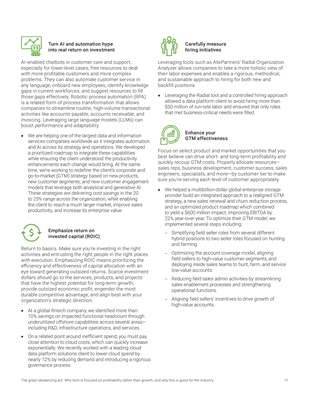
The great rebalancing act: Why tech is focused on profitability rather than growth, and why this is good for the industry 10
Turn AI and automation hype
into real return on investment
AI-enabled chatbots in customer care and support,
especially for lower-level cases, free resources to deal
with more profitable customers and more complex
problems. They can also automate customer service in
any language, onboard new employees, identify knowledge
gaps in current workforces, and suggest resources to fill
those gaps effectively. Robotic process automation (RPA)
is a related form of process transformation that allows
companies to streamline routine, high-volume transactional
activities like accounts payable, accounts receivable, and
invoicing. Leveraging large language models (LLMs) can
boost performance and adaptability.
• We are helping one of the largest data and information
services companies worldwide as it integrates automation
and AI across its strategy and operations. We developed
a prioritized roadmap to integrate these capabilities
while ensuring the client understood the productivity
enhancements each change would bring. At the same
time, we're working to redefine the client's corporate and
go-to-market (GTM) strategy based on new products,
new customer segments, and new customer engagement
models that leverage both analytical and generative AI.
These strategies are delivering cost savings in the 20
to 25% range across the organization, while enabling
the client to reach a much larger market, improve sales
productivity, and increase its enterprise value.
Emphasize return on
invested capital (ROIC)
Return to basics. Make sure you're investing in the right
activities and entrusting the right people in the right places
with execution. Emphasizing ROIC means prioritizing the
efficiency and effectiveness of capital allocation with an
eye toward generating outsized returns. Scarce investment
dollars should go to the services, products, and projects
that have the highest potential for long-term growth,
provide outsized economic profit, engender the most
durable competitive advantage, and align best with your
organization's strategic direction.
• At a global fintech company, we identified more than
10% savings on impacted functional headcount through
underutilized offshore capabilities across several areas-
including R&D, infrastructure operations, and services.
• On a related point around inefficient spend, you must pay
close attention to cloud costs, which can quickly increase
exponentially. We recently worked with a leading cloud
data platform solutions client to lower cloud spend by
nearly 12% by reducing demand and introducing a rigorous
governance process.
Carefully measure
hiring initiatives
Leveraging tools such as AlixPartners' Radial Organization
Analyzer allows companies to take a more holistic view of
their labor expenses and enables a rigorous, methodical,
and sustainable approach to hiring for both new and
backfill positions.
• Leveraging the Radial tool and a controlled hiring approach
allowed a data platform client to avoid hiring more than
$30 million of run-rate labor and ensured that only roles
that met business-critical needs were filled.
Enhance your
GTM effectiveness
Focus on select product and market opportunities that you
best believe can drive short- and long-term profitability and
quickly recoup GTM costs. Properly allocate resources-
sales reps, business development, customer success, sales
engineers, specialists, and more-by customer tier to make
sure you're serving each level of customer appropriately.
• We helped a multibillion-dollar global enterprise storage
provider build an integrated approach to a realigned GTM
strategy, a new sales renewal and churn reduction process,
and an optimized product roadmap which combined
to yield a $600 million impact, improving EBITDA by
22% year-over-year. To optimize their GTM model, we
implemented several steps including:
− Simplifying field seller roles from several different
hybrid positions to two seller roles focused on hunting
and farming.
− Optimizing the account coverage model, aligning
field sellers to high-value customer segments, and
deploying inside sales teams to hunt, farm, and service
low-value accounts.
− Reducing field sales admin activities by streamlining
sales enablement processes and strengthening
operational functions.
− Aligning field sellers' incentives to drive growth of
high-value accounts.